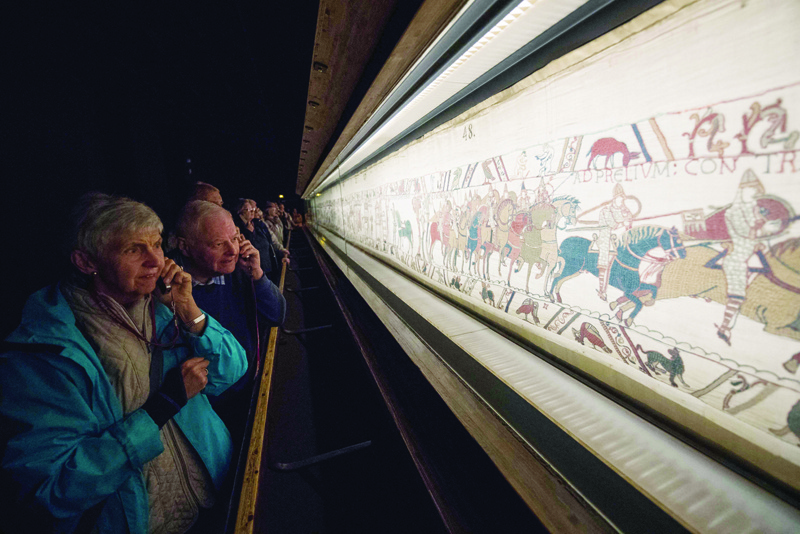 In these file photos visitors looks at the "Bayeux tapestry" or "Queen Mathilde tapestry" which relates Britain's conquest by William the Conqueror (Guillaume le Conquerant) in 1066, in Bayeux, western France.-AFP photos
In these file photos visitors looks at the "Bayeux tapestry" or "Queen Mathilde tapestry" which relates Britain's conquest by William the Conqueror (Guillaume le Conquerant) in 1066, in Bayeux, western France.-AFP photos
It has stood for over nine centuries as the most celebrated record of the 1066 Norman Conquest of England, its famous images cemented into the mind of every British school child. But for all its enduring power, the 70-metre (230 feet) long Bayeux Tapestry-held at a museum in the northern French town of the same name-is a fragile object suffering from wear-and-tear, including thousands of holes. It will now be restored for the first since 1870, two years after an agreement between Paris and London for the tapestry to be loaned to Britain.
"The tapestry is an old lady who is nearly 1,000 years old, a very, very fine linen canvas embroidered with wool which now shows multiple signs of damage," Antoine Verney, the chief curator of the museum, told AFP. "Any handling of the work in its current state can lead to new alterations. This is the main reason for this intervention."
10,000 holes
The Bayeux Tapestry depicts the events leading up to the Norman Conquest, a pivotal event in English history that transformed the country's language, culture and administration. Believed to have been made a few years after the conquest, it culminates with the defeat by William the Conquerer of Anglo-Saxon monarch Harold at the 1066 Battle of Hastings after the Norman ruler crossed the Channel with an invasion force. Generations of schoolchildren in Britain have learned about the battle through the tapestry and its legendary image of Harold being shot in the eye with a Norman arrow.
In January 2020, eight textiles experts inspected the tapestry, listed as a "memory of the world" artefact by UNESCO, recording nearly 24,200 stains and 10,000 holes. Repairs carried out over the centuries and "the exceptional dimensions of this work give the illusion of a good general state of conservation" but "the structural state of the canvas and support of the embroidery is very fragile and worrying", they said in a report.
Whether it will ever make the journey across the Channel to be shown in England largely depends on the tapestry's state of preservation. "It cannot travel until it is restored. But one question remains: Can it travel when it is restored," asked Verney. For the deputy mayor of Bayeux in charge of tourism, Loic Jamin, after its restoration, it will not be allowed to leave. "The only justification for possibly moving it is to restore it," he said.
Museum overhaul
The loan of the tapestry for display in Britain was announced at a meeting in 2018 between then prime minister Theresa May and French President Emmanuel Macron in what was seen as a sign that close Franco-British ties would endure after Brexit. They had stated the loan would take place in 2022 but this now appears impossible. Bayeux is the custodian of the work which belongs to the French state. Before the pandemic, the tapestry attracted 400,000 visitors per year, 70 percent of whom were from abroad.
Loaning the tapestry for display in England has been envisaged twice before but the plans never came to fruition. This was in 1953 for the coronation of Elizabeth II as queen and also in 1966 for the 900th anniversary of the Battle of Hastings. Even moving the tapestry into a workshop to review its condition required the mobilization of a 50-person team, Verney said. With a work that is as fragile as it is monumental, the aim is not to clean up all the stains or repair all the damage but to secure its current state.
And some alterations are of historical interest, such as traces of wax that may have been leaked from the candles of the Bayeux cathedral, where the tapestry was exhibited in the 15th century. Most worrying for the future of the work are the 10,000 holes, from nails or just wear and tear. In tandem with the restoration, the museum housing it will be rebuilt. The two million euro restoration should be launched in the autumn of 2024 and last at least 18 months, said Verney. - AFP





